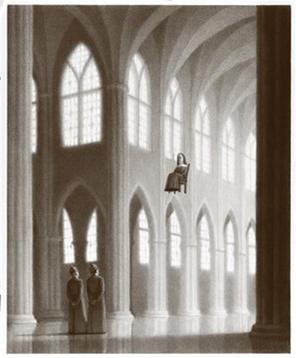 After Margaret Raymo's daughter was assigned to write a story based on one of The Mysteries of Harris Burdick in her third-grade class, the editor got an idea. She asked Chris Van Allsburg what he thought about publishing a collection of stories based on his artwork from Mysteries. "That's when he told me about the Stephen King story," Raymo said.
After Margaret Raymo's daughter was assigned to write a story based on one of The Mysteries of Harris Burdick in her third-grade class, the editor got an idea. She asked Chris Van Allsburg what he thought about publishing a collection of stories based on his artwork from Mysteries. "That's when he told me about the Stephen King story," Raymo said.
Raymo visited Van Allsburg with a list, and they sat at the table together. "I asked Chris to inscribe maybe 30 copies to begin with," she recalled. She still has inscribed books that never got sent out with an invitation to contribute a story. They sent the invitations one at a time because she and Van Allsburg wanted the authors to have a choice. "A few got away, but I understand they were very busy," she said.
The stroke of genius to include an introduction to the work of the elusive Harry Burdick from Lemony Snicket was, naturally, Lemony Snicket's idea, according to Raymo. "I sent it to him asking him to write a story, and he asked if he could write the introduction," she said. Van Allsburg liked the way the stories "all have the DNA of their authors on it." Raymo agreed, adding, "You get a flavor of the author's body of work, and they all took such a different approach." She didn't give the authors any direction whatsoever, only a word count.
Linda Sue Park ("The Harp") discovered Mysteries when she was fairly new to children's books. She remembered thinking how daring it was for the publisher to bring out a book of what were essentially unconnected illustrations. But she said that's nothing compared to the risk with this project. "To entrust those beautiful enigmatic drawings to a gang of rowdy, ungainly, wild-eyed, half-crazed writers," she said. "You bet I wanted in on that kind of fun!"
Gregory Maguire also confesses to a bit of skepticism when Raymo approached him about contributing a story for what he calls the "trippy, soft-focus, Life-magazine-circa-1947 drawings. They seem so solidly real and right that I hesitated to interfere," he said. Then Maguire thought, "Hey, I'm the bozo who interfered with The Wizard of Oz, for Pete's sake." Luckily, he'd been toying with a "sort of Hansel-und-Gretel tale called 'The Gingerbread Gondola,' " so the picture Missing in Venice (which also graces the volume's cover) seemed tailor-made for the author of Wicked. A former middle-school teacher, Maguire also admits to carving up a copy of The Mysteries of Harris Burdick as story starters for his students, because they "capture a peak moment in an implied narrative"--not unlike the ephemera dealer whose wares first inspired Van Allsburg in a flea market one day.
 Like Van Allsburg, Lois Lowry had been edited for many years by Walter Lorraine and had known both the author-artist and his Mysteries since the book's inception. Lowry's grandchildren had also used the book in school, but she made some demands. "I was delighted to be included," Lowry said, "but only, I told Margaret, if I could have the floating nun! That nun had fascinated me for years."
Like Van Allsburg, Lois Lowry had been edited for many years by Walter Lorraine and had known both the author-artist and his Mysteries since the book's inception. Lowry's grandchildren had also used the book in school, but she made some demands. "I was delighted to be included," Lowry said, "but only, I told Margaret, if I could have the floating nun! That nun had fascinated me for years."
Lowry's choice created some friction with Jon Scieszka, who had known and loved Mysteries since it came out. "It was one of those books that made me jealously wish I had come up with the idea... and also jealously wish I could draw like Chris," Scieszka admitted. When Raymo invited him to write a story, he said, "I knew exactly which picture I wanted to write about--the one of the floating nun in the chair," he said. But Lois Lowry had beaten him to the pick. "Since Lois had first dibs, she got to choose the weapons for our duel to settle the deadlock. She chose Newbery medals. I got whomped. Whomped bad," he said. Then he added in a whisper, "But don't tell anyone about it, okay? Because after I recovered, I had a great time coming up with a tale demented enough to go with the illustration for 'Under the Rug.' I really did."

